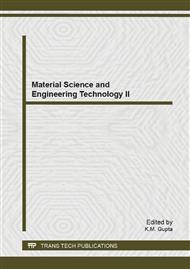p.3
p.9
p.16
p.22
p.25
p.29
p.36
p.43
p.48
Epoxy Emulsion Modified Engineered Cementitious Composite for Enhanced Pipeline Coating
Abstract:
A new class of Epoxy Emulsion modified Engineered Cementitious Composite (EM-ECC) has been developed for enhanced pipeline protection. The performance of typical ECC materials, such as flexural strength, anti-corrosion and early strength, has been improved by the addition of epoxy emulsion and rapid hardening cement. Our results indicated that the flexural strength of as-made EM-ECC increases with the increase of the EM/cement ratio after curing for 28 days. The retention rate of flexural strength of specimens remains analogical after immersed in water, 5 wt% Na2SO4 and 5 wt% NaCl solutions, respectively. The flexural strength reached ca. 16 MPa at 60 wt% replacement rate of rapid hardening cement after curing for 3 days. This new class of EM-ECC will shed light to the design of new applications for the oil and gas industry.
Info:
Periodical:
Pages:
25-28
Citation:
Online since:
December 2013
Authors:
Keywords:
Price:
Сopyright:
© 2014 Trans Tech Publications Ltd. All Rights Reserved
Share:
Citation:


